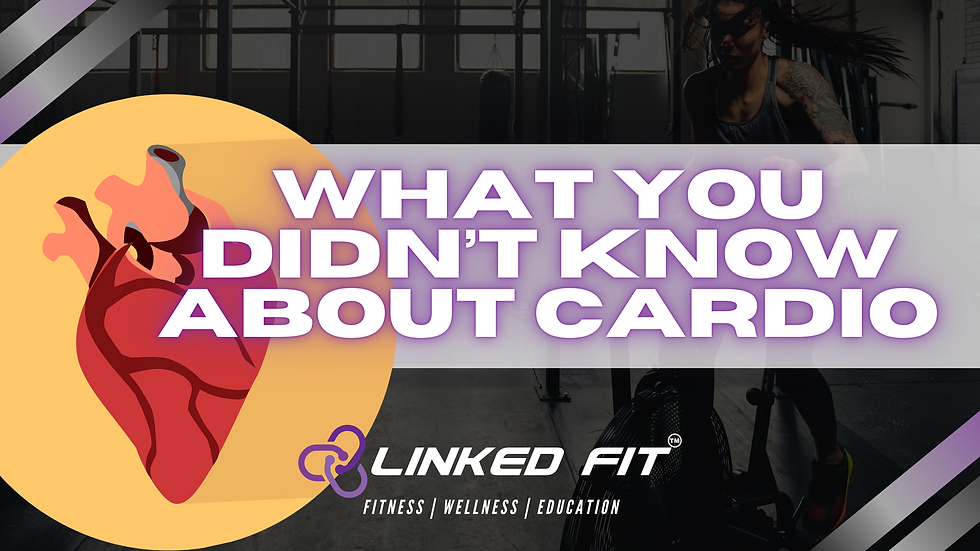Heart Rate Variability
- Linked Fit

- Feb 11, 2020
- 6 min read
Updated: Apr 24, 2021

In the world of recovery, a variety of factors need to be in play to understand the transition towards optimal recoverability. At Linked Fit, our key focus with EVERY client is promoting effective and efficient protocols to advance performance. With that said, recovery is never forgotten, as training responses will always be accompanied by a variety of fellow stressors. Each stressor impacts the body differently and can cause a mixture of physiological and psychological reactions.
These reactions can be detrimental to the growth of superior adaptation and also favorable in means of eustress. When the body experiences a stressor, the body is split towards making a decision of protection. Our body's natural instinct is to stay alive! Whether it is from a negative situation such as running from a lion or a positive such as recovering from a weight lifting training session. This article is focused on providing some understanding of heart rate variability, which is a key indicator of internal stressor monitoring. As you continue reading, you'll be provided information on heart rate variability and the variables within each data recording.

Autonomic Nervous System & Stress
Stressful situations will result in an autonomic nervous system response (McCraty & Atkinson, 2012). Although the autonomic nervous system produces sympathetic activity (i.e. fight or flight response), repeated activation over time can lead to allostatic overload. Cortisol is known to the main hormone triggered in stressful situations within the adrenal gland. Cortisol reduces protein breakdown, red blood cell production, yields catabolic physiological processes, and suppresses immunity (Lee et al., 2017). The roles from this unique biomarker have the potential indication to impair the capacity to recover and protein synthesis (Lee et al., 2017). Therefore, it is critical for officers to be resilient when experiencing a stressful situation, by preparing for it, recovering from it, and adapt to the stressor (McCraty & Atkinson, 2012).

Heart Rate Variability
Heart rate variability (HRV) represents the most reliable and quantitative measure of neurocardiac function via the dynamics of the autonomic nervous system (McCraty & Atkinson, 2012; Paul & Garg, 2012). The variability that exists in the heart rate rhythm is an indicator of physiological resiliency and an individual’s capacity to adapt to stressful demands (Andreassi, 1995; Purwandini Sutarto, Abdul Wahab, & Mat Zin, 2012). Therefore, indicating that variation is essential for autonomic nervous system function (Purwandini Sutarto et al., 2012). Greater HRV indicates an optimal interplay between the sympathetic and parasympathetic nervous systems (Lagos et al., 2008; Paul & Garg, 2012). Heart rates can be modified through noise, anxious thinking, breathing, emotions, pressure sensors in arteries, and other physiological and behavioral changes (Lagos et al., 2008; Mackersie Carol & Kearney, 2017; Paul & Garg, 2012).
Time-Domains

There are a variety of methods to evaluate variations in heart rate, time-domain measures are perhaps the simplest (Electrophysiology Task Force of the European Society of Cardiology the North American Society of, 1996). In an electrocardiograph (ECG), the QRS complex is identified with the normal-to-normal (NN) intervals is measured (Electrophysiology Task Force of the European Society of Cardiology the North American Society of, 1996). The variables from the ECG may be analyzed from the entire recording or calculated by utilizing smaller segments of the recorded period (Electrophysiology Task Force of the European Society of Cardiology the North American Society of, 1996). Of the time domain measures, the standard deviation of the NN interval is the simplest variable to measure which is known to reflect all cyclic components responsible for variability in the ECG recording (Electrophysiology Task Force of the European Society of Cardiology the North American Society of, 1996). The rMSSD is a frequently used parameter applied to the indication of parasympathetic cardiac control (Siegrist & Li, 2017). Higher time-domains values reflect the increased domination of sympathetic compared to the parasympathetic nervous system by a triggered stress response (Rodrigues et al., 2018). The NN50 is the number of pairs of adjacent NN intervals differing by more than 50 ms in the recording, while the pNN50 (based upon a percentage) is the NN50 divided by the total numbers of all NN intervals (Electrophysiology Task Force of the European Society of Cardiology the North American Society of, 1996).
Frequency-Domains

Frequency-domains is a representation of the power spectral density analysis, whereby this helps provide the information of how power (variance) distributes within the frequency of the heartbeat (Electrophysiology Task Force of the European Society of Cardiology the North American Society of, 1996). The distribution of power and central frequency of high-frequency and high-frequency are not established but are known to transform in autonomic modulations during heartbeats (Electrophysiology Task Force of the European Society of Cardiology the North American Society of, 1996). The high frequency has been reflected in the regulation of respiratory sinus arrhythmia (Goldstein, Bentho, Park, & Sharabi, 2011). The low-frequency power has been associated with baroreflex modulation of autonomic outflow (Goldstein et al., 2011). Although the time- and frequency-domain variables strongly correlated with each other via autonomic balance regulations, strong correlations exist because of the mathematical and physiological relationships between the two (Electrophysiology Task Force of the European Society of Cardiology the North American Society of, 1996). A low HRV is likely to determine a sympathetic predominance and decreased vagal tone, thus directly decrease the opportunities of restorative capacities of the autonomic nervous system (Siegrist & Li, 2017).
Each domain plays a significant role in defining the HRV recording. In recent years, a variety of user-friendly technologies are integrating the use of HRV within their systems, which can help provide a deeper understanding of cardiovascular health on an individual level. Although the systems may integrate the use of HRV technology, it is important to understand what the data means and each brand typically utilizes its own formula to determine the calculation. The purpose of this article was to provide a simple verification of the variables of HRV. As research continues to grow and technology advances, HRV will only evolve.
Reference:
Andreassi, J. L. (1995). Psychophysiology: Human behavior and physiological response, 3rd ed. Hillsdale, NJ, US: Lawrence Erlbaum Associates, Inc.
Blair, J. M., Fowler, K. A., Betz, C. J., & Baumgardner, J. L. (2016). Occupational Homicides of Law Enforcement Officers, 2003–2013. American Journal of Preventive Medicine, 51(5), S188-S196.
Charles, L. E., Burchfiel, C. M., Sarkisian, K., Li, S., Miller, D. B., Gu, J. K., . . . Andrew, M. E. (2015). Leptin, adiponectin, and heart rate variability among police officers. American Journal Of Human Biology: The Official Journal Of The Human Biology Council, 27(2), 184-191.
Electrophysiology Task Force of the European Society of Cardiology the North American Society of, P. (1996). Heart Rate Variability. Circulation, 93(5), 1043-1065.
Goldstein, D. S., Bentho, O., Park, M.-Y., & Sharabi, Y. (2011). Low-frequency power of heart rate variability is not a measure of cardiac sympathetic tone but may be a measure of modulation of cardiac autonomic outflows by baroreflexes. Experimental Physiology, 96(12), 1255-1261.
Kirschbaum, C., Pirke, K. M., & Hellhammer, D. H. (1993). The ‘Trier Social Stress Test’ – A Tool for Investigating Psychobiological Stress Responses in a Laboratory Setting. Neuropsychobiology, 28(1-2), 76-81.
Lagos, L., Vaschillo, E., Vaschillo, B., Lehrer, P., Bates, M., & Pandina, R. (2008). Heart Rate Variability Biofeedback as a Strategy for Dealing with Competitive Anxiety: A Case Study (Vol. 36).
Larsen, L. B., Tranberg, R., & Ramstrand, N. (2016). Effects of thigh holster use on kinematics and kinetics of active duty police officers. Clinical Biomechanics, 37, 77-82.
Lee, E. C., Fragala, M. S., Kavouras, S. A., Queen, R. M., Pryor, J. L., & Casa, D. J. (2017). Biomarkers in Sports and Exercise: Tracking Health, Performance, and Recovery in Athletes. The Journal of Strength & Conditioning Research, 31(10).
Lehrer, P. M., & Gevirtz, R. (2014). Heart rate variability biofeedback: how and why does it work? Frontiers in psychology, 5, 756-756.
Mackersie Carol, L., & Kearney, L. (2017). Autonomic Nervous System Responses to Hearing-Related Demand and Evaluative Threat. American Journal of Audiology, 26(3S), 373-377.
McCraty, R., & Atkinson, M. (2012). Resilience Training Program Reduces Physiological and Psychological Stress in Police Officers. Global advances in health and medicine, 1(5), 44-66.
Nieuwenhuys, A., Caljouw, S. R., Leijsen, M. R., Schmeits, B. A. J., & Oudejans, R. R. D. (2009). Quantifying police officers' arrest and self-defence skills: Does performance decrease under pressure? Ergonomics, 52(12), 1460-1468.
Nieuwenhuys, A., & Oudejans, R. R. D. (2010). Effects of anxiety on handgun shooting behavior of police officers: a pilot study. Anxiety, Stress, & Coping, 23(2), 225-233.
Nieuwenhuys, A., & Oudejans, R. R. D. (2011). Training with anxiety: short- and long-term effects on police officers’ shooting behavior under pressure. Cognitive Processing, 12(3), 277-288.
Paul, M., & Garg, K. (2012). The effect of heart rate variability biofeedback on performance psychology of basketball players. Applied Psychophysiology And Biofeedback, 37(2), 131-144.
Purwandini Sutarto, A., Abdul Wahab, M. N., & Mat Zin, N. (2012). Resonant Breathing Biofeedback Training for Stress Reduction Among Manufacturing Operators. International Journal of Occupational Safety and Ergonomics, 18(4), 549-561.
Rodrigues, S., Paiva, J. S., Dias, D., Pimentel, G., Kaiseler, M., & Cunha, J. P. S. (2018). Wearable Biomonitoring Platform for the Assessment of Stress and its Impact on Cognitive Performance of Firefighters: An Experimental Study. Clinical Practice & Epidemiology in Mental Health, 14(1), 250-262.
Sawni, A., & Breuner, C. C. (2017). Clinical Hypnosis, an Effective Mind-Body Modality for Adolescents with Behavioral and Physical Complaints. Children (Basel, Switzerland), 4(4), 19.
Siegrist, J., & Li, J. (2017). Work Stress and Altered Biomarkers: A Synthesis of Findings Based on the Effort–Reward Imbalance Model. International journal of environmental research and public health, 14(11), 1373.
Spangler, D. P., Williams, D. P., Speller, L. F., Brooks, J. R., & Thayer, J. F. (2018). Resting heart rate variability is associated with ex-Gaussian metrics of intra-individual reaction time variability. International Journal of Psychophysiology, 125, 10-16.





Comments